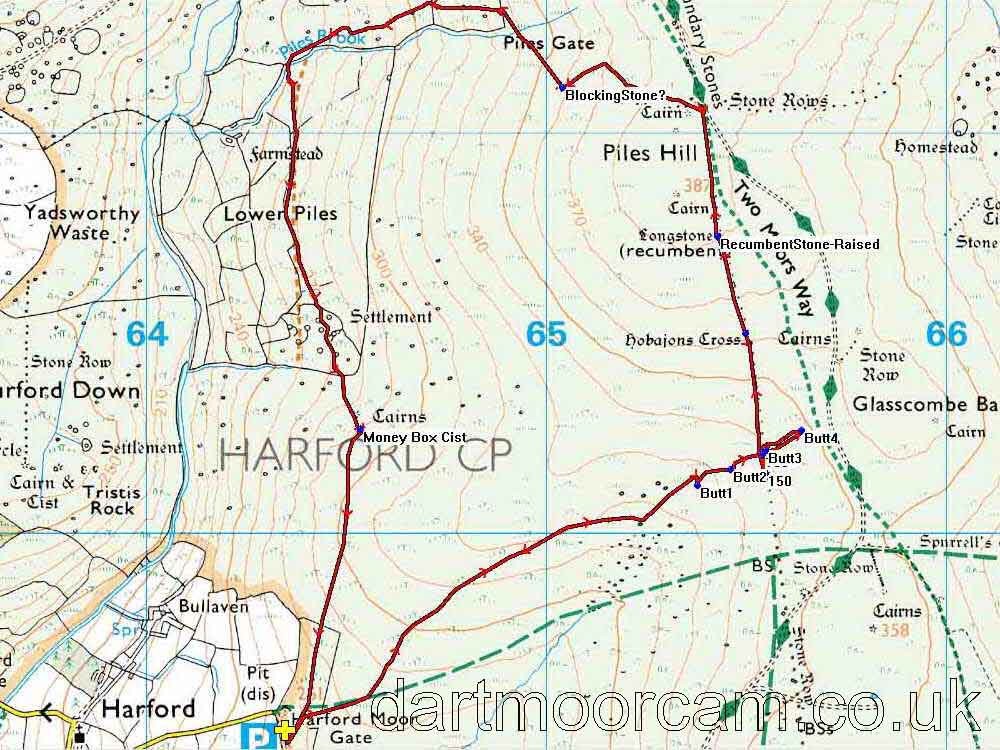


This walk: 2011-5-25. Butterdon rifle range butts, 100 & 150 yards marker stones, Hangershell Rock, Hobajohn's Cross, cloudscape, the Lazarus stone (formerly recumbent longstone), Redlake railway track, green hairstreak butterfly, china clay pipeline inspection pit, Erme valley, Piles Gate, Sharp Tor, bluebells, heath spotted orchid, Pile Copse, Hanger Down Clump, hut circles, buttercup, Money Box, cist, May blossom.
Walk details below - Information about the route etc.
Another walk in this area: 28 April 2011, up to Redlake china clay works, at the end of the dismantled railway track..
There are some extra photos taken on repeating this walk on 27th May 2011.
Observation Pit 1 (2D1) at SX 65380 60118, part of Butterdon Rifle Range, constructed during Oct. 1860, catering for 500 troops, abandoned 18 July 1861 after complaints about the troops' behaviour (to local women), activities (such as burning the moor) and sanitation problems. The pit now contains what appears to be an abandoned spring harrow i.e. scrap iron. Hangershell Rock behind .....
Observation Pit 2 (2C1) at SX 65462 60160. According to a Dave Brewer article in Dartmoor Magazine, no. 45, Winter 1996, pages 10-11: "Each of the four butts was assigned to a different regiment, No. 1 to the 2nd/12th, No. 2 to the 53rd, No. 3 to the 61st and No. 4 to the Royal Marines." Perhaps No. 1 was "2A1" and No. 4 was "2D1".
Observation Pit 3 (2B1) at SX 65548 60206 ..... with Butterdon stone row behind .....
Observation Pit 4 (2A1) at SX 65639 60255, with the old Harford Reservoir in the distance, surrounded by trees.
Zoomed view to Hangershell Rock.
100 yards marker stone at SX 65541
60197, close to the observation pit for this firing lane.
Note to self - never volunteer for observation pit duty on a rifle range!
150 yard marker at SX 65550 60149. There said to be 90 of these marker stones, approx. 8 x 5 inches, set flush with the ground.
Hobajohn's Cross, at SX 65513 60475.
Taken as a cloudscape - is that a new word? Showing summer high cirrus and stratocirrus clouds.
The Lazarus Stone - marked on the map as "Longstone (recumbent)" it is now upright again.
Another view of the re-erected Longstone, next to a boundary marker between Harford and Ugborough parishes.
Another parish boundary stone.
A view of the dismantled "Puffing Billy" tramway up to Redlake china clay works: established 1911, closed 1931. Surveyed by RH Worth it is 7 � miles long and runs between Redlake clayworks (at 449m) and Cantrell (at 274m). it was used to take men and materials (coal for steam engine, iron and general supplies). The walk linked above - 28 April 2011 - followed this track to its termination at Redlake china clay works.
A Green Hairstreak butterfly, Callophrys rubi.
An inspection pit for the pipeline that brought china clay slurry from Redlake down to the Ivybridge area.
Looking up the Erme valley .....
Somewhere before the next photograph, there was a terminal blocking stone, at SX 65042 61114, that I forgot to photograph. It is at the western end of the "Stone rows" marked on the map, although the rows themselves were not easily visible in this area.
This may be the feature recorded at SX 6501 6110 (on the Prehistoric Monuments of Dartmoor web site) and described as "possibly a cursus". It is described as "Piles Hill double stone row and cairns (fig. 54.22)" in Dartmoor Atlas of Antiquities, Jeremy Butler, 1993, Vol. IV, page 63. It straddles the old railway track.
Correction - photo taken on 27th May .....
Terminal blocking stone/s at the end of the double stone rows (which are almost invisible in this area), at SX 65042 61114.
Field corner at Piles Gate .....
Piles Gate with Sharp Tor behind .....
Piles Gate.
Looking north up to Sharp Tor.
Looking across to a large area of bluebells ..... a sign of ancient woodlands?
Zoomed view ..... Tristis Rock, Burford Down and Hall Plantation in the distance.
More zoom .....
Mother with twin lambs.
Heath spotted orchid, Dactylorhiza maculata subspecies ericetorum.
A Sphagnum moss ..... and that's as much as I can say about it!
As previous photo .....
As previous photo .....
As previous photo .....
Another view up the Erme valley, this time showing Piles Copse, one of the three ancient oak woodlands on Dartmoor.
More bluebells ......
Looking back at the bluebells.
Bluebells again.
Sheep with twins before bluebells.
Zoomed view to Hanger Down Clump.
Hut circle / roundhouse ..... close to the camera, now filled with bluebells, where did they come from?
Another roundhouse showing the door pillars.
Butterdon Buttercup?
The Money Box cist, SX 64537 60258 ..... It is described under "Butter Brook stone rows and the cairns on Piles Hill" in Dartmoor Atlas of Antiquities, Jeremy Butler, 1993, Vol. IV, page 30, fig. 53.9 (cairn 15), with a textual description on page 33 .....

©Jeremy Butler, Dartmoor Atlas of
Antiquities, 1993, Vol. IV, fig. 53.9, p. 30.
View of the deep burial chamber .....
The Money Box kistvaen, this must be one of the deepest cists on the moor?
Zoomed view to Harford church.
Hawthorn tree in May blossom.
MAP: Red = GPS satellite track of the walk.

Ordnance Survey © Crown copyright 2005. All rights reserved. Licence number
100047373.
Also, Copyright © 2005, Memory-Map Europe, with permission.
This walk was accessed by taking the road east from Cornwood, via Torr and Harford to Harford Moor Gate.
Statistics
Distance - 6.39 km / 4.01 miles
All photographs on this web site are copyright ©2007-2016 Keith Ryan.
All rights reserved - please email for permissions